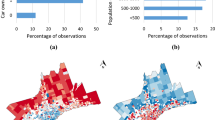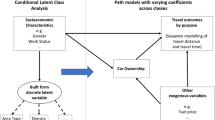Abstract
Efficient planning operations in the management of public transportation can benefit from more definitive understanding of the market structure of user demand. Market segmentation has been shown to be an effective method to guide the design of transit service offerings that can help transit agencies increase ridership and revenue. This study offers an integration of multivariate methodology for market segmentation in urban work commuting within a high technology corridor that has similarity to other such corridors in the US and worldwide. Adaptive choice conjoint analysis is first used to derive the importance weights of a set of attributes in terms of which service offerings for these commuters can be defined. This methodology allows respondents to more realistically indicate their preferences from full profiles of service offerings. A clustering procedure is then used to explore the grouping of individuals into homogeneous subsets of the sample that approximate market segments. Finally, the combinations of traveler demographics that differentiate clusters are examined with methodology of non-linear discriminant analysis. Access to and use of study methodologies by system analysts and designers is elaborated upon in an online appendix.



Similar content being viewed by others
Notes
As used here, intermodal will mean that at least one transfer is required in a work trip. This is frequently across modes (e.g., light rail to bus).
Smith (1956) emphasized that segments should have similar profiles (identifiability) and respond similarly to market mix variation (responsiveness). DeSarbo and Grisaffe (1998) stated that segmentation should satisfy accessibility, feasibility, membership identification and profitability criteria. Wedel and Kamakura (2012) proposed adding substantiality, stability and actionability criteria in evaluating a segmentation solution.
Identifiability refers to measurable criteria for differentiating segments. Substantiality refers to segment sizes. Accessibility refers to capabilities to reach the respective segments. Actionability refers to capabilities in delivering differences in measured attributes to segments that are identified. Responsiveness refers to differential sensitivities of market segments to differences in levels of attributes of an offering.
References
Abu-Lebdeh G (2012). Neural networks for travel time prediction on interrupted flow facilities. In: Transportation Research Board: Transportation Research Circular E-C168: Artificial Intelligence Applications to Critical Transportation Issues, Washington DC, pp 42–57
Aggarwal CC, Reddy CK (eds) (2013) Data clustering: algorithms and applications. CRC Press, West Palm Beach
Ajzen I (2011) Theory of planned behavior. In: Higgens T, Kruglangski A, Van Lange P (eds) Handbook of theoretical social psychology. Sage, Thousand Oaks, pp 438–459
Alderighi M, Cento A, Nijkamp P, Rietveld P (2012) Competition in the European aviation market: the entry of low-cost airlines. J Transp Geogr 24:223–233
Allen J, Levinson H (2014) Accommodation of long-term growth on North American’s commuter railroads. Transp Res Rec 2419:40–49
Beirão G, Cabral JS (2008) Market segmentation analysis using attitudes toward transportation: exploring the differences between men and women. Transp Res Rec 2067(1):56–64
Bernetti G, Longo G, Tomasella L, Violin A (2008) Sociodemographic groups and mode choice in a middle-sized European city. Transp Res Rec 2067(1):17–25
Binner S, Neggers R, Hoogerbrugge M (2009) “ACBC: a case study”, presented at the joint SKIM/Sawtooth Software Training Event. Czech Republic, Prague
Cascetta E (2013) Transportation systems engineering: theory and methods. Springer Science & Business Media, Dordrecht
Cascetta E, Papola A, Marzano V, Simonelli F, Vitiello I (2013) Quasi-dynamic estimation of o–d flows from traffic counts: formulation, statistical validation and performance analysis on real data. Transp Res B Methodol 55:171–187
Chapman BP, Goldberg LR (2011) Replicability and 40-year predictive power of childhood ARC types. J Pers Soc Psychol 101(3):593–606
de Oña J, de Oña R, Eboli L, Mazzulla G (2015) Heterogeneity in perceptions of service quality among groups of railway passengers. Int J Sustain Transp 9(8):612–626
DeSarbo WS, Grisaffe D (1998) Combinatorial optimization approaches to constrained market segmentation: an application to industrial market segmentation. Mark Lett 9(2):115–134
Doove LL, Van Buuren S, Dusseldorp E (2014) Recursive partitioning for missing data imputation in the presence of interaction effects. Comput Stat Data Anal 72:92–104
Eboli L, Mazzulla G (2007) Service quality attributes affecting customer satisfaction for bus transit. J Public Transp 10(3):21–34
Echeverri P, Skålén P (2011) Co-creation and co-destruction: a practice-theory based study of interactive value formation. Mark Theory 11(3):351–373
Elmore-Yalch R (1998) Using market segmentation to increase transit ridership. Transportation Research Board: TCRP report 36. National Academy Press, Washington DC
Everitt BS, Landau S, Leese M (2009) Cluster analysis. Wiley, London
Fellesson M, Friman M (2012) Perceived satisfaction with public transport service in nine European cities. J Transp Res Forum 47(3):93–103
Fleiss JL (2011) Design and analysis of clinical experiments. Wiley, New York
Gebauer H, Johnson M, Enquist B (2010) Value co-creation as a determinant of success in public transport services: a study of the Swiss Federal Railway operator (SBB). Manag Serv Qual 20(6):511–530
Gilmour P, Borg G, Duffy PA, Johnston ND, Limbek BE, Shaw MR (1994) Customer service: differentiating by market segment. Int J Phys Distrib Logist Manag 24(4):18–23
Goh CK, Tan KC, Liu DS, Chiam SC (2010) A competitive and cooperative co-evolutionary approach to multi-objective particle swarm optimization algorithm design. Eur J Oper Res 202(1):42–54
Green PE, Wind Y (1975) New way to measure consumers’ judgments. Harvard Business Review 53:107–117
Green PE, Krieger AM, Wind Y (2001) Thirty years of conjoint analysis: reflections and prospects. Interfaces 31(3 suppl):S56–S73
Grischkat S, Hunecke M, Böhler S, Haustein S (2014) Potential for the reduction of greenhouse gas emissions through the use of mobility services. Transp Policy 35:295–303
Gruel W, Piller FT (2016) A new vision for personal transportation. MIT Sloan Manag Rev 57(2):20–24
Gustafsson A, Herrmann A, Huber F (eds) (2013) Conjoint measurement: methods and applications. Springer Science and Business Media, Heidelberg
Hassan SS, Katsanis LP (1994) Global market segmentation strategies and trends. In: Hassan S, Kaynak E (eds) Globalization of consumer markets: structures and strategies. International Business Press, New York, pp 47–62
Huber J (2005) Conjoint analysis: how we got here and where we are. Sawtooth Software Research Paper Series, Sequim
Hunecke M, Haustein S, Böhler S, Grischkat S (2010) Attitude-based target groups to reduce the ecological impact of daily mobility behavior. Environ Behav 42(1):3–43
Iseki H, Taylor BD (2010) Style versus service? An analysis of user perceptions of transit stops and stations. J Public Transp 13(3):23–48
Kaufman L, Rousseeuw PJ (2009) Finding groups in data: an introduction to cluster analysis. Wiley, Hoboken
Krieger AM, Green PE (1996) Modifying cluster-based segments to enhance agreement with an exogenous response variable. J Mark Res 33:351–363
Lemon SC, Roy J, Clark MA, Friedmann PD, Rakowski W (2003) Classification and regression tree analysis in public health: methodological review and comparison with logistic regression. Ann Behav Med 26(3):172–181
Liu H, Cai Z, Wang Y (2010) Hybridizing particle swarm optimization with differential evolution for constrained numerical and engineering optimization. Appl Soft Comput 10(2):629–640
Liu Y, Kiang M, Brusco M (2012) A unified framework for market segmentation and its applications. Expert Syst Appl 39(11):10292–10302
Louviere JJ, Islam T (2008) A comparison of importance weights and willingness-to-pay measures derived from choice-based conjoint, constant sum scales and best-worst scaling. J Bus Res 61(9):903–911
Ludlow LH (2010) Classical test theory, item response theory, and Rasch measurement principles: transforming psychometric theory into practice. Larry H. Ludlow, Chestnut Hill
Lusch RF, Vargo SL, Wessels G (2006) Toward a conceptual foundation for service science: contributions from service-dominant logic. IBM Syst J 47(1):5–14
Melaniphy MP (2015) Hearing on “Surface Transportation Reauthorization”. Testimony before Senate Committee on Banking, Housing and Urban Affairs. U.S. Senate. American Public Transportation Association, Washington DC
Mikhaylov AS, Gumenuk IS, Mikhaylova AA (2016) Russian public transport system: the customers’ feedback on the service provision. Public Transp 8(1):125–141
Murtagh F (1983) A survey of recent advances in hierarchical clustering algorithms. Comput J 26(4):354–359
Murtagh F, Legendre P (2014) Ward’s hierarchical agglomerative clustering method: which algorithms implement Ward’s criterion? J Classif 31(3):274–295
Nourbakhsh SM, Ouyang Y (2012) A structured flexible transit system for low demand areas. Transp Res Part B Methodol 46(1):204–216
Perrotta A (2013) Fare collection and fare policy. Transit Leadership Summit. Research Papers, pp 1–8
Rao VR (2014) Applied conjoint analysis. Springer, New York
Redman L, Friman M, Gärling T, Hartig T (2013) Quality attributes of public transport that attract car users: a research review. Transp Policy 25:119–127
Reinke D (2012) Urban travel demand forecasting. In: Transportation Research Board: Transportation Research Circular E-C168: Artificial Intelligence Applications to Critical Transportation Issues, Washington DC, pp 86–92
Schlereth C, Skiera B (2012) Measurement of consumer preferences for bucket pricing plans with different service attributes. Int J Res Mark 29(2):167–180
Schneider RJ (2013) Theory of routine mode choice decisions: an operational framework to increase sustainable transportation. Transp Policy 25:128–137
Scott RA, George BT, Prybutok VR (2016) A public transportation decision‐making model within a metropolitan area. Decis Sci 47:1048–1072
Shiftan Y, Outwater ML, Zhou Y (2008) Transit market research using structural equation modeling and attitudinal market segmentation. Transp Policy 15(3):186–195
Siggerud K (2006) Intermodal transportation: challenges to and potential strategies for developing improved intermodal capabilities. Testimony before the Subcommittee on Highways, Transit and Pipelines, Committee on Transportation and Infrastructure, U.S. House of Representatives Thursday, June 15, Washington DC
Silver S (2012) Assessing importance and satisfaction judgments of intermodal work commuters with electronic survey methodology. In: Proceedings of the Decision Science Institute. Decision Science Institute, Atlanta
Small K (2013) Urban transportation economics, vol 4. Harwood, Reading
Smith WR (1956) Product differentiation and market segmentation as alternative marketing strategies. J Mark 21:3–8
Stroby C, Mally J, Tutz G (2009) An introduction to recursive partitioning: rationale, application and characteristics of classification and regression trees, bagging and random forests. Psychol Methods 14(4):323–348
Train KE (2009) Discrete choice methods with simulation. Cambridge University Press, Cambridge
United States Government Accountability Office (2010) Public transportation: report to Congressional Committees, Report GAO-10-781
Vanoutrive T, Van De Vijver E, Van Malderen L, Jourquin B, Thomas I, Verhetsel A, Witlox F (2012) What determines carpooling to workplaces in Belgium: location, organisation, or promotion? J Transp Geogr 22:77–86
Vargo SL, Akaka MA (2009) Service-dominant logic as a foundation for service science: clarifications. Serv Sci 1(1):32–41
Vicente P, Reis E (2016) Profiling public transport users through perceptions about public transport providers and satisfaction with the public transport service. Public Transp 8(3):387–403
Waara N, Brundell-Freij K, Risser R, Ståhl A (2015) Feasible provision of targeted traveler information in public transportation: segmentation based on functional limitations. Transp Res Part A Policy Pract 74:164–173
Wardman M (2001) A review of British evidence on time and service quality valuations. Transpo Res Part E Logist Transp Rev 37(2):107–128
Wardman M (2004) Public transport values of time. Transp Policy 11(4):363–377
Wedel M, Kamakura WA (2012) Market segmentation: conceptual and methodological foundations. Springer Science and Business Media, Chicago
Weiner E (2008) Urban transportation planning in the United States: history, policy and practice, 3rd edn. Springer, Westport
Wen CH, Wang WC, Fu C (2012) Latent class nested logit model for analyzing high-speed rail access mode choice. Transp Res Part E Logist Transp Rev 48(2):545–554
Xie C, Lu JY, Parkany E (2003) Work travel mode choice modeling with data mining: decision trees and neural networks. Transp Res Rec 1854:50–61
Yaya LHP, Fortià MF, Canals CS, Marimon F (2015) Service quality assessment of public transport and the implication role of demographic characteristics. Public Transp 7(3):409–428
Zolfaghari A, Sivakumar A, Polak JW (2012) Choice set pruning in residential location choice modelling: a comparison of sampling and choice set generation approaches in greater London. Transp Plan Technol 35(1):87–106
Author information
Authors and Affiliations
Corresponding author
Rights and permissions
About this article
Cite this article
Silver, S.D. Multivariate methodology for discriminating market segments in urban commuting. Public Transp 10, 63–89 (2018). https://doi.org/10.1007/s12469-017-0169-8
Accepted:
Published:
Issue Date:
DOI: https://doi.org/10.1007/s12469-017-0169-8




